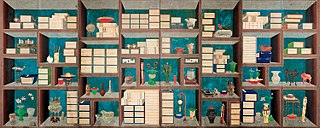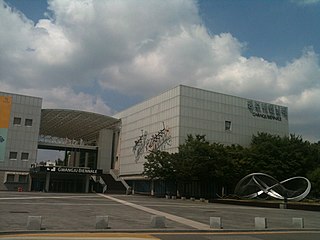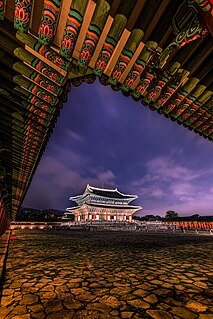 W
WKorean arts include traditions in calligraphy, music, painting and pottery, often marked by the use of natural forms, surface decoration and bold colors or sounds.
 W
WAnak Tomb No. 3 is a chamber tomb of Goguryeo located in Anak, South Hwanghae, North Korea. It is known for mural paintings and an epitaph. It is part of the Complex of Koguryo Tombs.
 W
WHwanbyeokdang or Hwanbyeokdang Pavilion is a garden pavilion, located in the neighborhood of Chunghyo-dong, Buk-gu of Gwangju, near Damyang County in South Jeolla Province of South Korea. It was built by Sachon on the hill behind his house. Hwanbyeokdang was named 'Hwanbyeokdang' by Sinjam, and a rough translation is 'a place surrounded by green trees and water.' It was also previously called "Byeokgandang" (벽간당).
 W
WIn Korean art history, the Baekje smile is the common smile motif found in Baekje sculpture and bas-relief. Baekje figures express a unique smile that has been described as both enigmatic and subtle. The smile has been also been characterized in many different ways from "genuinely glowing" to "thin and mild" to "unfathomable and benevolent".
 W
WBangjja (방짜), also called yugi, is a Korean type of hand-forged bronzeware. A complete set of Bangjja includes dishes, bowls, spoons, and chopsticks. The main difference between Korean bronzeware or Bangjja from other bronzeware is the alloy ratio between copper and tin. The Bangjja contains much more tin than other bronzewares while the normal ratio of tin to copper is 1/9. Due to this compositional difference, Bangjja can be sterilized. For this reason, it has historically been used as tableware for the royal families of Korea. Bangjja is used for the traditional presentation of Korean royal court cuisine (surasang). In 1983, the government of South Korea has officially designated Bangjjaa as an Important Intangible Cultural Property.
 W
WThe Bell of Cheonheungsa is from the Cheonheungsa Temple near Seonggeo Mountain in Chungcheongnam-do Province. The Bell of Cheonheungsa is regarded as one of the largest and most beautiful bells from the Goryeo period. The bell is listed at number 280 in the "National Treasures of South Korea" list. It is made from bronze and has a height of 1.33m, with a bell inlet of 0.96m.
 W
WThe Bell of King Seongdeok is a large bronze bell, the largest extant bell in Korea. The full Korean name means "Sacred Bell of King Seongdeok the Great." It was also known as the Emille Bell, after a legend about its casting, and as the Bell of Bongdeoksa Temple, where it was first housed.
 W
WThe Bell of Sangwonsa is a bronze bell designated as National Treasures of South Korea #36. It is located in the Sangwonsa temple in Pyeongchang County, Gangwon Province.
 W
WThe Bell of Yongjusa is located in the temple of Yongjusa, near Suwon, Gyeonggi Province, South Korea.
 W
WThe Capital Cities and Tombs of the Ancient Koguryo Kingdom is a UNESCO World Heritage Site which includes a number of archaeological sites currently in Ji'an, Jilin Province and Huanren, Liaoning Province in Northeast China., was a Korean kingdom located in the northern and central parts of the Korean Peninsula and the southern and central parts of Manchuria.
 W
WChaekgeori, translated as "books and things", is a genre of still-life painting from the Joseon period of Korea that features books as the dominant subject. The chaekgeori tradition flourished from the second half of the 18th century to the first half of the 20th century and was enjoyed by all members of the population, from the king to the commoners, revealing the infatuation with books and learning in Korean culture.
 W
WChanggeuk or ch'angguk is a traditional Korean opera, performed as a play but in the Korean folk song style known as pansori. It is therefore also called Korean pansori opera in English. Generally, a changgeuk play will include 20 to 30 actors, and 30 to 50 orchestra members.
 W
WThe Crown of Baekje refers to several artifacts excavated that are believed to be the royal headgear of the kings, queens, and nobility of the Baekje Kingdom. Some of the crowns follow the same tradition as Silla crowns in that they share the tree-motif and the hints of shamanistic traditions. However, the diadems of the kings and queens suggest that Baekje people had a distinct tradition for their royal headgear.
 W
WThe crowns of Gaya refers to two excavated pieces that are believed to be the headgear of the elite of the Gaya Confederacy. These crowns share the general traditions of Korean crowns, such as the use of diadems, which follows the tradition of the Baekje and the use of headbands with uprights, most notably used in the crowns of Silla. However, the Gaya crowns are obviously distinctive from the traditions of the Silla and Baekje and shows that the Gaya people enjoyed an independent culture.
 W
WThe crowns of Silla were made in the Korean kingdom of Silla approximately in the 5th–7th centuries.
 W
WThe history of Asian art includes a vast range of arts from various cultures, regions and religions across the continent of Asia. The major regions of Asia include Central, East, South, Southeast, and West Asia.
 W
WKorean flower arrangement is being revived as an indoor art, and most often uses simple Joseon dynasty whiteware to highlight Korean flowers and tree branches in elegant and unforced natural arrangements. Im Wha-Kong of Ewha Woman's University in Seoul, who also makes her own ceramic wares, is the greatest living exponent of this art, and hosts quarterly displays of flower arrangements keeping this tradition alive. There are at least a dozen schools of traditional flower arrangements.
 W
WGatbawi or Stone Seated Medicine Buddha at Gwan Peak, Mt. Palgong in Gyeongsan is a Buddhist statue in Daehan-ri, Wachon-myeon, Gyeongsan, Gyeongsangbuk-do, the Republic of Korea. It was made in the Unified Silla Kingdom era and is well known with the name of Gatbawi Buddha. It sits 4 metres (13 ft) tall, and the hat is a 15-centimetre (6 in) thick flat stone on his head,
 W
WGeumbak is a Korean traditional craft for applying extremely thin gold leaf on hanbok, or other fabrics for decoration. Artisans who specialize in the technique are called geumbakjang (금박장).
 W
WGobeunok or Gogok are comma-shaped or curved beads and jewels that appeared from prehistoric Korea through the Three Kingdoms of Korea.
 W
WGoguryeo art is the art of Goguryeo, an ancient Korean kingdom which occupied large areas of present-day Northeast China and Korea. Its distinct style is marked by flowing lines and vivid colors. The prime examples of this style are tomb murals excavated in North Korea and Manchuria, which were produced from the 3rd to 7th centuries.
 W
WGoguryeo tombs, officially designated as the Complex of Koguryo Tombs, are tombs in North Korea. In July 2004, they became the first UNESCO World Heritage site in the country. The site consists of 30 individual tombs from the later Goguryeo kingdom, one of Three Kingdoms of Korea, located in the cities of P'yŏngyang and Namp'o. Goguryeo was one of the strongest ancient Korean kingdoms located in the northern and central parts of the Korean Peninsula and the southern and central parts of Manchuria. The kingdom was founded in the present day area of North Korea, and part of Manchuria around 37 BCE, and the capital was transferred to P'yŏngyang in 427 CE.
 W
WThe Gwangju Biennale is a contemporary art biennale founded in September 1995 in Gwangju, South Jeolla province, South Korea. The Gwangju Biennale is hosted by the Gwangju Biennale Foundation and the city of Gwangju. The Gwangju Biennale Foundation also hosts the Gwangju Design Biennale, founded in 2004.
 W
WGyeongcheonsa Pagoda is National Treasure of Korea No. 86. It was designated by the South Korean government on December 20, 1962.
 W
WThe Gyeongju Folk Craft Village is a village at the foothills of Toman mountain, in the neighborhood of Ha-dong, Gyeongju, North Gyeongsang province, South Korea. The village was established in 1986 to preserve and develop crafts of the Silla kingdom. It consists of hanok or traditional Korean houses including 45 thatched houses and roof-titled houses (giwajip) where artisans of the Gyeongju origin live and work.
 W
WHelmet of eight plates in the Korean style is a helmet produced between 14th and 16th centuries in either Korean peninsula or Mongolia. This helmet consists of eight plates made of iron. It is speculated that this helmet style was spread to Korean peninsula from the Tibetan regions. Helmets with similar structure can be seen in Tibet, while both versions of the helmet are made of iron and leather. But Korean-style eight plated helmets are distinguished from those of Tibetan style by its relatively smaller size. Usually a Tibetan-style eight plated helmet measures 21–22 cm in height. But this Korean style helmet measures only 13 cm in height. Currently displayed at the Metropolitan Museum of Art, New York, the Korean style helmet measures 24.3 cm in length and 21 cm in width and 1065.9 g in weight.
 W
WThe tradition of Korean jade carving dates back to neolithic finds along the Namgang river basin in Gyeongju. Jade rings and accessories were worn by the higher classes of society, especially women, from the three kingdoms period and reached their peak in the Joseon dynasty, the golden age of jadework. Korean jadework often includes Buddhist motifs, cicadas, and peanut-shaped good luck talismans on the small scale, as well as larger-scale architectural pieces.
 W
WKkokdugaksi Noreum is a type of traditional puppet play from Korea. It was developed in 18th century Joseon Dynasty era by Namsadang troupe which is a group of traveler artists. Namsadang traveled all over Korea and entertained the commoners.
 W
WKorean architecture refers to an architectural style that developed over centuries throughout Korea. Korea’s architectural origin is largely Chinese. Main reason can be attributed to China being active near and within Korea, e.g. Four Commanderies of Han and Gojoseon, among few, which were ruled by Chinese. Influence of China and adoption by Korea continued throughout history because of relations and sinicization.
 W
WThe Korean Bell of Friendship is a massive bronze bell housed in a stone pavilion in Angel's Gate Park, in the San Pedro neighborhood of Los Angeles, California. Located at the corner of Gaffey and 37th Streets, the section of the park is alternatively called the "Korean–American Peace Park" and occupies part of the former Upper Reservation of Fort MacArthur.
 W
WKorean pagodas are a traditional Korean architectural form that began in the Three Kingdoms of Korea period. Koreans created a unique and distinct pagoda tradition using stone.
 W
WKorean painting includes paintings made in Korea or by overseas Koreans on all surfaces. The earliest surviving Korean paintings are murals in the Goguryeo tombs, of which considerable numbers survive, the oldest from some 2,000 years ago, with varied scenes including dancers, hunting and spirits. The Takamatsuzuka Tomb in Japan, from the 7th-century end of the Goguryeo period, has paintings in Goguryeo style that were either done by Korean artists, or Japanese one trained by Koreans. But more often influences came into Korea from China. Until the Joseon dynasty the primary influence was Chinese painting though done with Korean landscapes, facial features, Buddhist topics, and an emphasis on celestial observation in keeping with the rapid development of Korean astronomy.
 W
WKorean ceramic history begins with the oldest earthenware from around 8000 BC. Throughout the history, the Korean peninsula has been home to lively, innovative, and sophisticated art making. Long period of stability have allowed for the establishment of spiritual traditions, and artisan technologies specific to the region. Korean ceramics in Neolithic period have a unique geometric patterns of sunshine, or it's decorated with twists. In Southern part of Korea, Mumun pottery were popular. Mumun togi used specific minerals to make colors of red and black. Korean pottery developed a distinct style of its own, with its own shapes, such as the moon jar or Buncheong sagi which is a new form between earthenware and porcelain, white clay inlay celadon of Goryeo, and later styles like minimalism that represents Korean Joseon philosophers' idea. A lot of talented Korean potters were captured to Japan after the porcelain war in 1592–1598. Arita ware, founded by Yi Sam-pyeong opened a new era of porcelain in Japan. Another Japanese representative porcelain, Satsuma ware was also founded by Dang-gil Shim and Pyeong-ui Park. 14th generation of Su-kwan Shim have been using the same name to his grandfather and father to honor they are originally Korean, 14th Su-kwan Shim is honorable citizen of Namwon, Korea.
 W
WMinhwa refers to Korean folk art produced mostly by itinerant or unknown artists without formal training, emulating contemporary trends in fine art for the purpose of everyday use or decoration. The term "minhwa" was coined by Yanagi Muneyoshi.
 W
WA Needle Woman is a performance video artwork created by artist Kimsooja. The videos projected simultaneously that comprise Kimsooja's A Needle Woman (1999) presents the artist wearing precisely the same clothes, standing precisely the same way, and, it would seem, at the same time of day in various urban environments.
 W
WThe traditional Korean color spectrum, also known as Obangsaek, is the color scheme of the five Korean traditional colors of white, black, blue, yellow and red. In Korean traditional arts and traditional textile patterns, the colors of Obangsaek represent five cardinal directions:Obangsaek theory is a combination of Five Elements and Five Colours theory and originated in China.
 W
WAn oil-paper umbrella is a type of paper umbrella that originated in China. It subsequently spread across several East, South and Southeast Asian countries such as Japan, Malaysia, Myanmar, Bangladesh, India, Sri Lanka, Thailand and Laos, where it has been further developed with different characteristics.
 W
WSeveral gold girdles of Korea have been excavated. They were symbols of royalty and status, but lesser belts were also worn by governmental officials. These belts have been found in the tombs of Silla and Baekje kings, queens, and the lesser nobility. The lesser girdles can be distinguished based on their size, material, and color. All royal girdles follow a general scheme. The royal girdles are made from pure gold metal plates attached to each other and are adorned with many charms, such as gogok. The symbolism of these charms and their significance has yet been fully ascertained. The practice of wearing girdles probably derives from Chinese traditions. They were generally accessories that were either worn on a crown or pieces of jewellery that symbolized wealth.
 W
WSeated Bodhisattva is a statue of a Bodhisattva belonging to mid-17th century, Joseon dynastic period of Korean peninsula. The statue, made of gilt wood, was originally one of the two attendant Bodhisattva figures that flanked a central Shakyamuni or Amitabha Buddha statue. It is believed that this Bodhisattva was the left attendant Bodhisattva of the triad. The tall ornate crown, oblong face and drapery with cascading folds of the statue indicate that the statue was probably produced in a Buddhist sculpture school in South Jeolla province, Korea. This statue was granted to the Metropolitan Museum of Art by Mary and Jackson Berke Foundation in 2015.
 W
WSuseok (수석), also called viewing stones or scholar's stones, is the Korean term for rocks resembling natural landscapes. The term also refers to the art of stone appreciation. The stone may be hand-carved or naturally occurring, with natural stones being of greater value. Such stones are similar to Chinese gongshi and Japanese suiseki.
 W
WKorean swords have served a central place in the defense of the nation for thousands of years. Although typical Korean land battles have taken place in wide valleys and narrow mountain passes, which favor use of the spear and bow, the sword found use as a secondary, close-quarters weapon, especially useful during sieges and ship-to-ship boarding actions. Higher quality, ceremonial swords were typically reserved for the officer corps as a symbol of authority with which to command the troops. Ceremonial swords are still granted to military officials by the civilian authority to this day.
 W
WTheater in Korea or Korean theater are theater performances which were originally done in courtyards although have now moved to stages. It is performed in the Korean language and is generally made up of those of Korean descent. Rising to prominence in ancient Korea, Korean theater remains vibrant today and is now gaining popularity around the world.
 W
WThread Routes is a 16mm film series by artist Kimsooja.
 W
WThe tiger has been strongly associated with Korean people and Korean culture. It appears in not only the Korean foundation mythology but also in folklore, as well as a favorite subject of Korean art such as painting and sculpture. The mascot of the 1988 Summer Olympics held in Seoul, South Korea is Hodori, a stylized tiger to represent Korean people.